Hack:
People connect to change
We hacked the system by creating an open space – Conexões 2.0 – where IT teams interacted and developed projects with people from many other areas of Natura. This yielded novel approaches to developing solutions to business challenges, brought up innovation in different fronts, new connections and promoted innovation and collaboration culture at Natura.
Funded in 1969, Natura is the biggest Brazilian manufacturer of cosmetics, toiletries and beauty products and leader in the direct selling industry in Brazil, with annual revenue exceeding US$ 3.2 billion.
The company has nearly 7.000 employees, working in operations in Brazil, Argentina, Chile, Colombia, Peru, Mexico, and France. It has currently more than 1.5 million consultants, who advise on usage and sell products, helping disseminate the company’s value proposition to consumers.
Natura´s operations are anchored by a complex set of business and sales information systems. Like many other companies worldwide, corporate information technology (IT) teams are traditionally structured, somewhat hierarchical and have little tolerance for the expected error and failure outcomes associated to the development of innovative solutions.
The traditional IT functional structure was set to work mainly on back-office and front-office automation processes. The innovation and management practices were driven top-down, and projects were implemented throught waterfall methodologies, with extensive planning and test phases at their timelines.
However, IT´s contributions can deliver additional value at countless aspects of Natura´s business, promoting new ways for people to relate to each other, improving information and intelligence flow, thus enabling radical change and evolution of the enterprise into the new era of mobility, social network connections, human capital and big data.
Our challenge was to trigger two changes at Natura Cosmetics. The first one was to disseminate the insertion of digital tools and resources into the organization and business practices, helping to promote and accelerate an organizational transformation of Natura into a digital business. The second was to do so by working in a different model, highly collaborative, non-hierarchical and rapid, aiming at the desired collateral effect of changing the organization culture in the process. We realised that this would not be an IT-only task, so this hack was conducted in collaboration with people from several other areas of the company on themes related to digital business that emerged from the group.
The opportunity we addressed was to develop innovative and relevant technological offers to the business, promoting the mindset shift from the traditional fragmented, process- and function-driven working model of IT into a new mindset of "IT as an integral player of Natura´s digital business". In this new vision, IT is no longer a function, becoming a dimension of the company, focusing its work to improve business performance, create new business opportunites and promote customer and employee interaction.
The digital innovation culture becomes then a bottom-up employee-driven model, and projects can be implemented through agile methodologies, improved by user experience on beta models, reducing project lifecycles and enhancing the created value.
First, we created an open space to promote interconnection and conversations of people about digital technology opportunities and projects. Initiatives would then have a chance of attracting people´s interest, and engage them on collaborating. This open space was called Conexões 2.0 (Connections 2.0).
The concept was implemented on 2-3 hour bi-monthly meetings, sponsored by Natura´s CIO, where people could gather and talk. These meetings were open to participation of anyone interested, either from IT, or from any other area of the company. We had a clear purpose of creating an interaction space for accelerating projects and fostering innovation.
There is a combination of aspects that contributed to get the “new mindset” message across, but we believe the most relevant was the conscious effort to “walk the talk” at all times, and relay the messages via each one of the engaged participants, and not via one single person. Three main messages were repeated over the initial meetings: 1) that we were trying a new approach to collaboration, 2) participation was voluntary, and 3) there was no formal process to be followed. Our CIO was actively engaged as a sponsor of the movement and constantly reinforced these messages. For instance, when people instinctively turned to him for decisions and approval, as CIO, he took these opportunities to act as part of the group, and not as a senior manager. As things progressed, this “in person” endorsement was no longer necessary, as peopled became more engaged, meetings became very informal, and people that participated acted as true ambassadors of the movement, helping to recruit newcomers into a mindset changing experience. Also, colleagues from internal corporate communications helped us to construct a “manifesto” of the movement and launch an internal campaign called “Mude” (change) - described below, which helped spread the mindset change to several other initiatives of the company.
The group participants determined the agenda of the meetings prior to the venues. Projects that were relevant for several areas of the company, and also new ideas for specific solutions for different business challenges were presented, discussed and enriched by participants on each meeting.
It was a consensus that Conexões 2.0 should not have the attribution of approving project stages. It should focus in connecting people and efforts for improving execution and delivery value of each initiative. Also, project activities and general execution were carried out by the project teams/communities, independently of Conexões 2.0 meetings.
The Conexões 2.0 initiative matured internally and influenced a larger corporate culture shift movement, latter called "Change" ("Mude", in Portuguese). The "Change" movement expressed itself in several formats, such as "Change to Connect", that focused upon initiatives aiming to bring up mobility and digital collaboration at work, and "Change to Transform", focusing upon new work models and innovation culture, amongst others.
Our Change movement brought several benefits to Natura in 2013, both tangible and intangible. The cultural shift seeds that the 70 people directly involved brought forth, and the online network they became, represent the latter.
Before Conexões 2.0, the conventional way of working on innovative projects and initiatives at Natura was by following a structured process, either for new product development, or for corporate projects. These followed guidelines and templates based on PMBOK, with stagegate approvals and dedicated project teams. As a result of the fifteen+ meetings we had, involving people from more than ten areas, we devised and tested a new collaborative working model, carried out by "project communities" that were self-organized by affitnity with the themes. At some stages of the process, the projects were subjected to formal appovals in the hierarchy, as they involved changes in the formal processes of the organization.
We delivered as a group over 10 prototypes of new services and improved processes at Natura. The tangible benefits include project that delivered solutions for mobility, collaborative work, sales and corporate challenges. Some of them are outlined and described and greater detail below, grouped according to the Change actions the movement addressed.
![]()
The Change (Mude) icon series
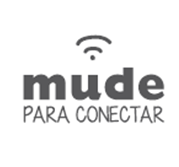 "Change to Connect" - The Conexões 2.0 meetings were themselves a new connection and collaboration model, crushing the traditional interaction channels defined by organizational silos and sharply redefined working roles. People participating in the events could also continue connected online, through a Sharepoint 2013 website with plenty of interaction tools, such as Newsfeed, Discussion Lists, Project Sharing Webparts, and so on. Direct, transparent, person-to-person connections were enabled, linking peoples’ ideas and workforce from across different organizational spheres.
"Change to Connect" - The Conexões 2.0 meetings were themselves a new connection and collaboration model, crushing the traditional interaction channels defined by organizational silos and sharply redefined working roles. People participating in the events could also continue connected online, through a Sharepoint 2013 website with plenty of interaction tools, such as Newsfeed, Discussion Lists, Project Sharing Webparts, and so on. Direct, transparent, person-to-person connections were enabled, linking peoples’ ideas and workforce from across different organizational spheres.
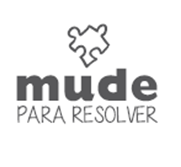 "Change to Solve" - The project implemented in this perspective is called "CATI Interativa", a different digital support system that gives individuals more choice over the way to find answers to questions and solutions to problems. The traditional support system consisted of a Help Desk model, with a call center operated by third-party attendants, and set scripts to address employees solicitations. "CATI Interativa" brought freedom to employees to choose new ways to communicate their problems and share them with an on-line community. In addition to the support provided by the traditional Help Desk, other employees willing to cooperate with their skills and knowledge could share on the problem-solving tasks, even if they were from IT distant areas, but had the skills to contribute. Solutions can now come from everyone, and people can find these by themselves without the need to put a formal request.
"Change to Solve" - The project implemented in this perspective is called "CATI Interativa", a different digital support system that gives individuals more choice over the way to find answers to questions and solutions to problems. The traditional support system consisted of a Help Desk model, with a call center operated by third-party attendants, and set scripts to address employees solicitations. "CATI Interativa" brought freedom to employees to choose new ways to communicate their problems and share them with an on-line community. In addition to the support provided by the traditional Help Desk, other employees willing to cooperate with their skills and knowledge could share on the problem-solving tasks, even if they were from IT distant areas, but had the skills to contribute. Solutions can now come from everyone, and people can find these by themselves without the need to put a formal request.
Video that ilustrates the creative process and execution of CATI Interativa (made by the Project team) - http://www.youtube.com/watch?v=d38W8HX1g6U
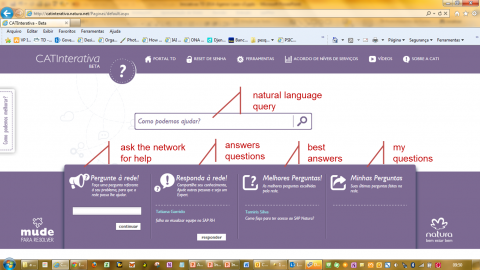
Screen print of CATI Interativa with some of its functions
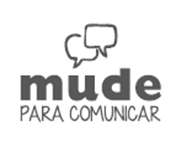 "Change to Communicate" - The main project in this topic is called Mobility, implementing a new set of digital phone calling and video conferencing tools (operated by Microsoft Lync), enabling employees to connect remotely with others from any space in, or outside Natura. This enhanced the communication experience and increase remote connections, yielding freedom to people to choose from where they work, when they work, how they work, and with whom they work. In addition, we also devised a new policy for distributing smartphones to Natura´s employees, regardless of hierarchical ranks. The company´s Mobility Team negotiated a innovative device/service package with the cell phone provider (Vivo) and created a mix of BYOD and service advantages for users that adopted the packaged. Employees could chose from a set of different smartphones, spread payment of the device over a period of two years, and calls amongst Natura´s phone numbers, business calls indicated on the bill and data trafic would not be charged for. This new policy/service enabled significant cost reduction of user´s bills (sometimes up to 75-80%) with the benefit of creating a highly interconnect network of people with access to e-mail, Lync messages and conference call services. Now-a-days,700 users are included in this movement.
"Change to Communicate" - The main project in this topic is called Mobility, implementing a new set of digital phone calling and video conferencing tools (operated by Microsoft Lync), enabling employees to connect remotely with others from any space in, or outside Natura. This enhanced the communication experience and increase remote connections, yielding freedom to people to choose from where they work, when they work, how they work, and with whom they work. In addition, we also devised a new policy for distributing smartphones to Natura´s employees, regardless of hierarchical ranks. The company´s Mobility Team negotiated a innovative device/service package with the cell phone provider (Vivo) and created a mix of BYOD and service advantages for users that adopted the packaged. Employees could chose from a set of different smartphones, spread payment of the device over a period of two years, and calls amongst Natura´s phone numbers, business calls indicated on the bill and data trafic would not be charged for. This new policy/service enabled significant cost reduction of user´s bills (sometimes up to 75-80%) with the benefit of creating a highly interconnect network of people with access to e-mail, Lync messages and conference call services. Now-a-days,700 users are included in this movement.
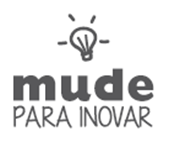 "Change to Innovate" - A new innovation process, called "Tecnovação", was created to challenge all employees to propose technology-based projects that addressed solutions to business needs, and that could be implemented in a 60 day period with a predefined budget. The trial run was open to IT personnel in the scope of a pilot experiment. Proposals were voted online by the social network tool at Natura´s Sharepoint, and the top voted bid was implemented. The gammification stimulated more than 30% of the IT employees to participate, and the winner implemented an App designed to help Natura’s Sales Team and received an international training program as a prize.
"Change to Innovate" - A new innovation process, called "Tecnovação", was created to challenge all employees to propose technology-based projects that addressed solutions to business needs, and that could be implemented in a 60 day period with a predefined budget. The trial run was open to IT personnel in the scope of a pilot experiment. Proposals were voted online by the social network tool at Natura´s Sharepoint, and the top voted bid was implemented. The gammification stimulated more than 30% of the IT employees to participate, and the winner implemented an App designed to help Natura’s Sales Team and received an international training program as a prize.
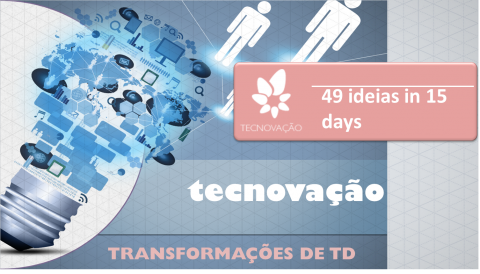
Some other projects are still undergoing development at this point, and all share very positive evaluations of their project communities regarding the benefits of being conducted according to the Conexões 2.0 framework. Amongst 2014 projects developed collaboratively, we can highlight the new platform of Movimento Natura (www.movimentonatura.com.br), an initiative that brings together social projects developed by Natura´s sales representatives (Consultants) and volunteers that wish to collaborate in their execution. This project was born in the new model and prototyped in record time and at very low cost. The final platform was launched in May 2014.
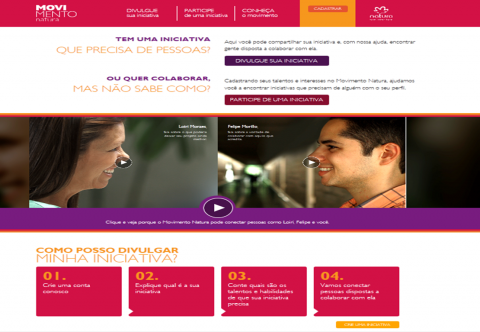
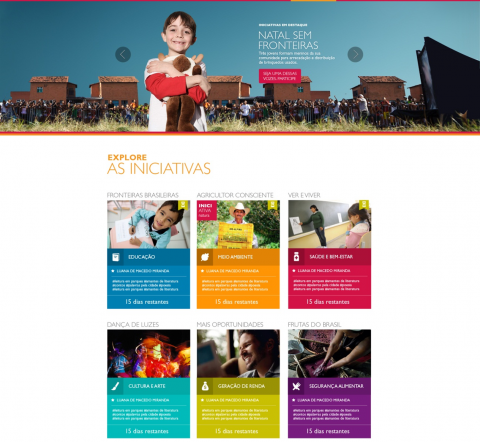
Site pages of Movimento Natura
Challenges to our network movement were mainly related to people management process and communication, given the fact that this new connection model was being adopted by people from very diverse areas, coming from a wide range of hierarchical statuses in the company. We did envisage some of the impacts that could arise from this movement, but did make a conscious decision of letting many of its aspects to emerge during the run, running it as a beta trial.
Despite being plainly an engaging open space that invited people to participate, create and collaborate, this new model challenged the traditional hierarchical matrix and well established organizational structure of the company. Thus, it was not a simple task to communicate its principles and purpose to people that had not experienced it. This was a critical aspect, as we needed to create awareness and invite people to be part of the movement in order to reach critical mass, and also enough diversity to enable it to run fully.
To start, we needed to characterize Conexões 2.0 as an "open space" for interaction and innovation in a simple manner. We believed that successful outcomes would be generated if the space were not perceived as an "IT-only" meeting or forum. This was achieved by clearly stating the purpose of the experimental practice from the beginning, and reinforcing it to participants and newcomers in all of the meetings, stimulating them to invite other people that could potentially enjoy engaging in it. Thus, all recruitment was based on individual interest and the desired to be a part of it, contribute with one´s expertise, work together and share knowledge. Besides IT, people from areas such as Innovation, Human Resources, Finance, Ombudsman, Corporate Communications, Marketing, Logistics and Operations, Legal Department, and Manufacturing participated in the meetings and project executions.
Without prior knowledge, we ended-up prototyping the "dual-organization model", with hierarchy and network operated in sinergy, as described by John P. Kotter in his recently launched book (Accelerate: Building Strategic Agility for a Faster-Moving World, Harvard Business Press Books, 2014). According to Kotter, this coexistence of working models is the future of organizations. To endure in the organization, the network side of it must be institutionalyzed, that is, recognized by the organization as a legitimate and desired way of working, accessible to people from all the company´s quarters. Our one-year experiment prototyped the initial and middle stages of Kotter´s implementation directives, from creating a sense of urgency arount an opportunity up to building up business result arguments. This enabled us to get experience and propose our next step - the institutional change of the working model at Natura.
Here we show a video explaining the manifesto of Conexões 2.0 (http://www.youtube.com/watch?v=kcXVEqom4JE), that ilustrates the entire proposal of this Hack. Although it is in Portuguese, one may be able to percieve the natural aspect of the network formed, and the atmosphere of high personal engagement, atesting the success of the movement amongst it´s participants.
Another key element was to look up for support of the Culture and Corporate Communications areas in order to produce some official endomarketing materials. This resulted in the "Mude" concept and design, as described earlier.
In order to enhance commitment to the movement, and to gain empowerment, our CIO Sponsor participated only at the initial meetings and reinforced an attitude of being "just one of the crowd". This was critical to endorse the movement as a light, non-hierarchical interaction space. In some meetings, the absence of the Sponsor CIO did not have any negative impact on the group outcome.
Last, we were also supported by colleagues from Human Resources as part of the movement´s team of heroes. They helped us on the evaluation of the movement as a whole and acted as sponsors of the experiment in different areas of the organization.
We envisage that we now have some substantial evidence for implementing a next step of the movement, working towards institutionalizing the practice at Natura, with support from HR. Also, IT can provide a significant constributions in terms of implementing a digital platform to promote dissemination of ideas and projects in the network model and connecting people to the new initiatives that come up. A business inteligence mechanism must be put in place to match people´s interests and expertise profiles to keywords from ideas and projects added to the platform, and this may be handled on a very interactice way in order to promote adoption and engagement of people. As ideas or people´s profiles are typed in, this may action may trigger immediate match responses to proponents and link actions to network members.
To start a cultural shift movement like ours, as part of a digital transformation, an enterprise needs to have the "digital vision" as a key part of its strategic plan. The necessity of a new mindset must be real and clear. As the digital transformation of our business is clearly expressed as driver for innovation and sustainability, that will help building the Natura of the future, it was relatively straightforward to anchor our movement around this aspect.
Then, the movement needs a sponsor with a strong lead position in the company. A sponsor that genuinely believes this is a reasonable and productive experiment that could speed up and produce better business outcomes. In our case, this person was the CIO.
Naturally, the heroes (or rebels at work) will appear from the employee crowd. And they will need empowerment to make things different.Inviting them to participated in a organized network-style movement, without hierarchies, but, at the same time spondored by the CIO, constructed the right scenario of a trustworthy and endorsed movement that allowed people´s natural leadership to emerge.
Last, the group should have a bit of organization and discipline to track the results they achieve and inspire others to join them, while not forgetting the freedom required to create and innovate.
As outcomes from the new form of work will be compared to those obtained from traditional execution modes, one must remember that results must also be formatted and presented using traditional metrics. Proof that the new way of work is more productive, innovative and efficient must be gathered in order for the experiment to fully accepted, replicated and expanded within the company. We did measure some of such basic aspects, such as time-to-market, project costs and contribution/business value to the organization, including tangible traditional metrics, such as productivity, and some non-tangible, such as positive impacts to innovation culture change and people´s self-fulfillment at work.
The initial credit is for our CIO Sponsor, Agenor Leão, who brought up the idea and developed it in conversations with several of the participants prior to implementing it in first semester of 2013.
Needless to say that this movement extrapolated physical presence at Conexões 2.0 meetings, so we also wish to recognize and thank each and all of the participants and enthusiasts that believed in connecting people to inspire relevant changes. Thank you!
We are also gratefull to Polly LaBarre for the encouragement, critical comments and suggestions that greatly enriched our Hack.
Video that describes Conexões 2.0 - legends are in Portuguese, but you can activate the automatic English translation of the subtitles at Youtube) - http://www.youtube.com/watch?v=kcXVEqom4JE
Video that describes CATI Interativa - this is not subtitled - http://www.youtube.com/watch?v=d38W8HX1g6U
Video that describes Movimento Natura - this is not subtitled - http://www.youtube.com/watch?v=jcQUhskyQzU
Congratulations is very interesting to see the results!
- Log in to post comments
Thanks Angela. We just revised and updated the Hack. Check it out again.
Cheers, Gilson
- Log in to post comments
Hi Gilson,
Great submission. Congratulations.
Can I ask how you made it clear to everyone that a new mindset was required to get them to be part of the movement?
Thanks in advance.
- Log in to post comments
Dear Mike, thanks for the positive comments.
I guess there is a combination of things that contributed to get the “new mindset” message across, but I believe the most relevant aspect was that we consciously tried to “walk the talk” at all times and relay the messages via each one of the engaged participants, and not via one single person. Three main messages were repeated over the initial meetings: 1) that we were trying a new approach to collaboration, 2) participation was voluntary, and 3) there was no formal process to be followed. Our CIO was actively engaged as a sponsor of the movement and constantly reinforced these messages. For instance, when people instinctively turned to him for decisions and approval, as CIO, he took these opportunities to act as part of the group, and not as a senior manager. As things progressed, his endorsement was no longer necessary for things to run in the group, and the meetings became more informal. People that participated acted as true ambassadors of the movement then, helping to recruit newcomers into a mindset change experience. People from internal corporate communications also helped us to construct a “manifesto” of the movement and launch an internal campaign called “Mude” (change), spreading the mindset change to several other initiatives of the company, which helped us in paralel.
I hope this answers your question, but fell free to ask more.
Cheers, Gilson
- Log in to post comments
Dear Gilson, congratulations for the project, for the results, and thanks for sharing. Natura is already recognized as one of the references for innovation and innovative practices in Brazil. I hope this hack "People connect to change" will inspire other professionals and companies not only here but in many other parts of the world.
- Log in to post comments
Dear Henry, thanks for the encouragement. We do hope this Hack inspires movement in other companies. All the best, Gilson
- Log in to post comments






You need to register in order to submit a comment.